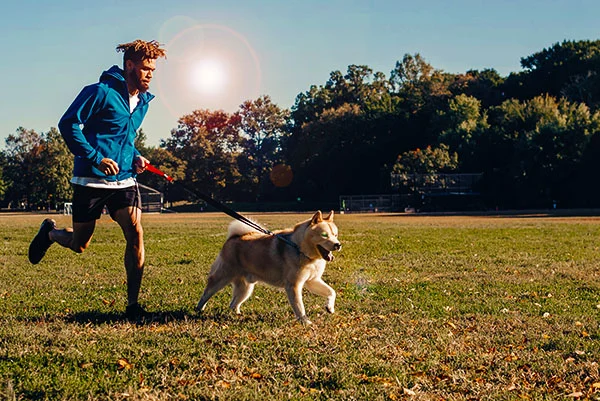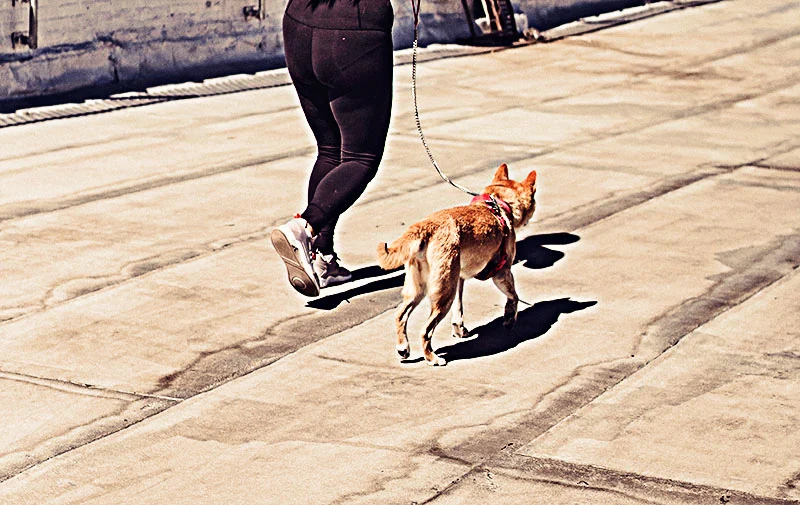You have probably thought about it before, but can a dog actually run alongside you as you take your daily jog? The answer may not surprise you, but it is important to read the following advice before you embark on any form of new exercise with your dog. It is also important to note that not all breeds are created equal and some can handle, and even thrive on more exercise than others. And how often should you run with your dog?
Is it bad to run with your dog?
Running with your dog can be a great way to stretch and strengthen his or her back legs, particularly if you have a dog who is a fair or better runner. Dogs are active animals, and it is natural for them to want to run. It is more natural for them to run with you than to be restricted to a leash when you go out for a jog.
As with any exercise program, be sure to talk to your veterinarian first before starting a jogging program. Your veterinarian may have concerns about your dog’s weight, age, breed or other factors that would make jogging unsafe. Also, be careful not to over-exercise your dog.

What are the potential risks?
The potential issues of jogging with your dog are: Your dog may be a poor runner and can’t keep up or has joint problems. If your dog is a good runner he may run ahead or is hard to keep up with. If you are running with your dog, and he or she runs ahead of you, you may have to stop frequently. Another issue is that the dog wants to run with you every time you go out for a jog. Another issue that can arise is that your dog is in danger of being hit by a car or truck. Some dogs may have an unknown heart condition or other medical condition that makes it risky to run.
Which breeds of dog can you go running with?
Some dogs are better than others at jogging. If you have a dog who is not a good runner, or if he or she has joint problems that make running risky, you shouldn’t jog with your dog. Sledge dogs, for example, were bred to run in harnesses, and they are not built to be jogging companions. Dogs with joint problems should not be jogged on the pavement.
How fast can a dog run?
Dogs can run at speeds up to 35 mph. Although this is the top speed that the majority of dogs can run, there are some that are able to run even faster.
Is jogging good for dogs?
Jogging is good for a dog because it helps them to burn calories and get exercise. It reduces the risk of obesity and helps the dog live a longer life. If you’re planning on taking your dog jogging, it’s best to start slow and build up their stamina. You wouldn’t expect a human who is not used to running to be able to start running a marathon straight away. Jogging with a dog is similar to jogging with people, except you need very little to get started.
Does running on concrete hurt a dog’s paws?
Not everyone will have access to ideal rural terrains such as beaches, woodlands and soft grassy areas. So you may end up considering running on asphalt or tarmac or even concrete, but is this a good idea for your dog?
If you go jogging on harder surfaces, it can be tough on the pads of a dog’s paws and may also cause bone, muscle or ligament issues. Be careful not to put excess stress on your dog’s joints. If you can, try and vary the surfaces that your dog goes running on. The key is to start small and build up.
Your dog’s paw pads will strengthen and become tougher. Over time, as long as you take them for small runs, before building them up they will become stronger.

Is it better to walk or run?
There’s a lot of debate on this matter, and the discussion is intense because pet owners are so concerned about their dogs’ health and general well-being. Some dog owners believe that dogs should be walked because it promotes better mental health and a better bond between dog and owner.
On the other hand, other dog owners believe that running with a dog is the best way to get them in shape, and it’s much better for their overall health. Some even opt to add training vests which can be slightly controversial.
The primary advantage of walking a dog is that it promotes a better bond between the dog and the owner. Dogs that are walked regularly are less likely to act out in ways that are destructive, and they are more likely to have stable mental health.
How old should a dog be to go running?
Your dog should be at least 6 months old before you even consider taking them running for the first time. Once a puppy has reached 9 months of age, then he may be able to run further and on a variety of surfaces, including concrete. Ensure that they are adequately well-trained to be allowed off a leash, especially if there are other dogs and people nearby, as they may be at risk of overstimulating the dog.
Should older dogs jog?
Older dogs have more advantages than disadvantages. They are experienced and less likely to get injured. Make sure you have had a couple of good walks first to make sure your dog has emptied his bladder and bowels. Age brings stiff joints and muscles. Your dog may be slower than a pup, but he will keep up with you. Enjoy the time together.
In summary
The best person to assess the overall situation of your dog is your local veterinarian. Be sure to consult professional advice to review your personal situation and the well-being of your dog if you are taking your dog for even a run longer than a few minutes. This is especially true if the walk is on concrete or a more urban area than a dog’s natural grassy or earthy environment,